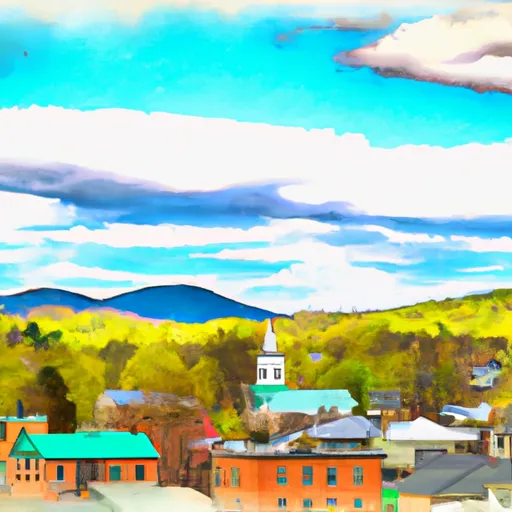-
 Snoflo Premium
Snoflo Premium
Get unlimited access to all our content
With no Ad interruptions! - Start Your Free Trial Login with existing account
Roxbury
Eden Index
Climate
7.1
•
Recreation
4.2
•
Community
1.0
•
Safeguard
4.6/10

Roxbury, Vermont is a small town located in Washington County in the central part of the state. The climate in Roxbury is characterized by cold winters with average temperatures ranging from 10°F to 30°F (-12°C to -1°C) and warm summers with average temperatures ranging from 60°F to 80°F (16°C to 27°C). The area experiences moderate precipitation throughout the year, with snowfall occurring during the winter months.
Hydrology constituents in Roxbury include several rivers and streams, with the Dog River being the most prominent waterway. These water bodies provide opportunities for fishing, kayaking, and other water-based recreational activities. The natural landscape of Roxbury also offers numerous hiking trails, allowing visitors to explore the picturesque forests and enjoy the beauty of the surrounding mountains.
Outdoor enthusiasts can take advantage of the town's proximity to the Green Mountain National Forest, which offers abundant opportunities for camping, hiking, mountain biking, and wildlife viewing. The area is known for its scenic beauty, making it a popular destination for nature lovers and those seeking a peaceful retreat. With its diverse outdoor recreation opportunities and beautiful natural surroundings, Roxbury, Vermont is an ideal destination for those looking to explore and enjoy the great outdoors.
What is the Eden Index?
The Snoflo Eden Index serves as a comprehensive rating system for regions, evaluating their desirability through a holistic assessment of climate health, outdoor recreation opportunities, and natural disaster risk, acknowledging the profound impact of these factors on livability and well-being.
Climate Health Indicator (CHI): 7.1
Roxbury receives approximately
1158mm of rain per year,
with humidity levels near 79%
and air temperatures averaging around
6°C.
Roxbury has a plant hardyness factor of
4, meaning
plants and agriculture in this region thrive during a short period during spring and early summer. Most
plants will die off during the colder winter months.
By considering the ideal temperature range, reliable water supplies, clean air, and stable seasonal rain or snowpacks, the Climate Health Indicator (CHI) underscores the significance of a healthy climate as the foundation for quality living.
A healthy climate is paramount for ensuring a high quality of life and livability in a region, fostering both physical well-being and environmental harmony. This can be characterized by ideal temperatures, reliable access to water supplies, clean air, and consistent seasonal rain or snowpacks.
Weather Forecast
Streamflow Conditions
Upper Connecticut
Area Rivers
Upper Connecticut
Snowpack Depths
Upper Connecticut
Reservoir Storage Capacity
Upper Connecticut
Groundwater Levels
Recreational Opportunity Index (ROI): 4.2
The Recreational Opportunity Index (ROI) recognizes the value of outdoor recreational options, such as parks, hiking trails, camping sites, and fishing spots, while acknowledging that climate plays a pivotal role in ensuring the comfort and consistency of these experiences.
Access to outdoor recreational opportunities, encompassing activities such as parks, hiking, camping, and fishing, is crucial for overall well-being, and the climate plays a pivotal role in enabling and enhancing these experiences, ensuring that individuals can engage in nature-based activities comfortably and consistently.
Camping Areas
| Campground | Campsites | Reservations | Toilets | Showers | Elevation |
|---|---|---|---|---|---|
| Greendale | 11 | 1,738 ft | |||
| Little River State Park | 100 | 731 ft | |||
| Gifford Woods State Park | 48 | 1,606 ft | |||
| Elmore State Park | None | 1,637 ft | |||
| Calvin Coolidge State Park | 60 | 1,684 ft | |||
| Chittenden Brook | 17 | 1,844 ft | |||
| Underhill State Park | None | 1,969 ft | |||
| Smugglers Notch State Park | 34 | 1,934 ft | |||
| Allis State Park | 26 | 1,875 ft | |||
| Silver Lake State Park | 40 | 1,385 ft |
Nearby Fishing
Nearby Ski Areas
Catastrophe Safeguard Index (CSI):
The Catastrophe Safeguard Index (CSI) recognizes that natural disaster risk, encompassing floods, fires, hurricanes, and tornadoes, can drastically affect safety and the overall appeal of an area.
The level of natural disaster risk in a region significantly affects safety and the overall livability, with climate change amplifying these risks by potentially increasing the frequency and intensity of events like floods, fires, hurricanes, and tornadoes, thereby posing substantial challenges to community resilience and well-being.
Community Resilience Indicator (CRI): 1.0
The Community Resilience Indicator (CRI) recognizes that education, healthcare, and socioeconomics are crucial to the well-being of a region. The CRI acknowledges the profound impact of these elements on residents' overall quality of life. By evaluating educational resources, healthcare accessibility, and economic inclusivity, the index captures the essential aspects that contribute to a thriving community, fostering resident satisfaction, equity, and social cohesion.

